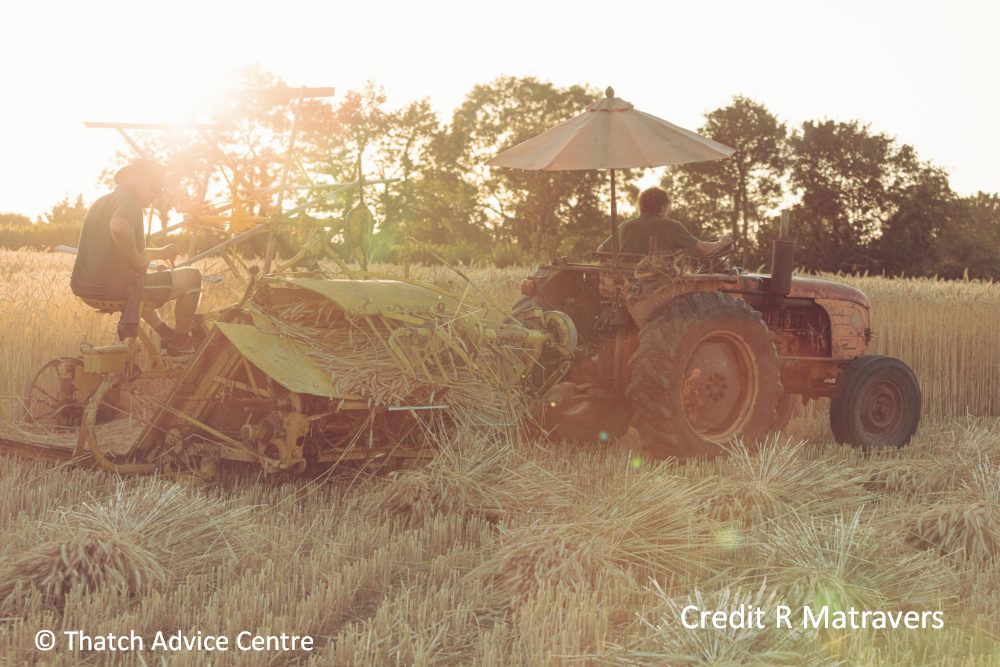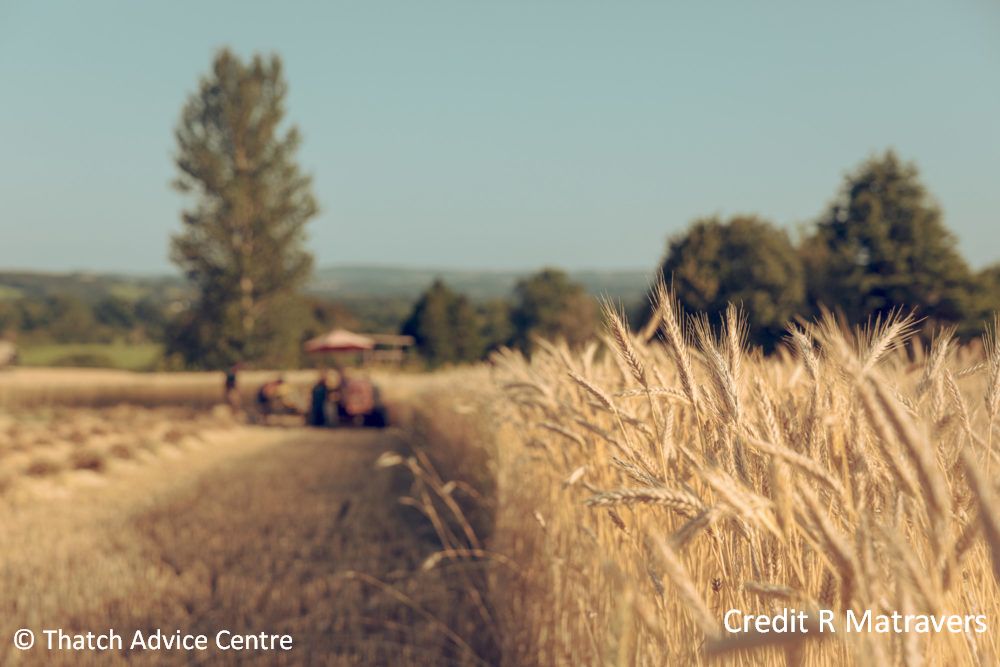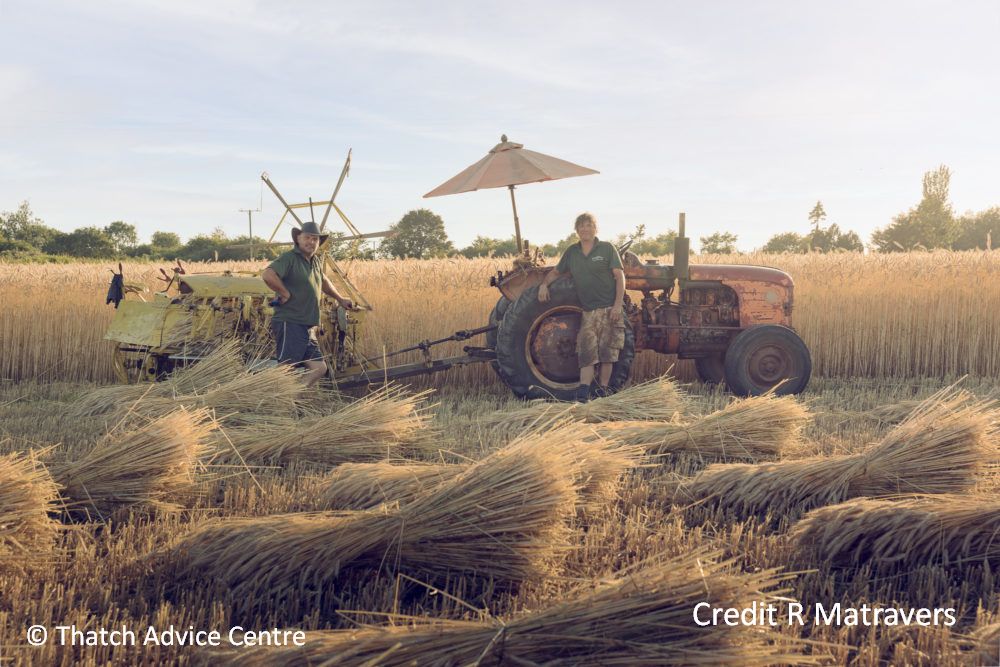Historic England Traditional Thatch Research Update – April 2024
We are so pleased to bring you a Traditional Thatch Research Update from Historic England. Over the past few years we, and others like the NTSGA (National Thatching Straw Growers Association), have been pleased our and others identifying issues and starting to highlight them, have resulted in various traditional thatch research projects being undertaken. This is an update following on from the Thatching Straw Harvesting workshop, held in June 2023.
These research projects have therefore been driven by those with a passion for keeping our historic thatched buildings and the materials, tradition, application, style and techniques involved. Historic England have, in listening to these situations evolving and acknowledging the issues, looked into doing research to help conserve the buildings traditions and associated material production. Thatching Straw and spars are the main focus of this Thatch Research Update.
Historic England have been supportive and, we hope will continue to be, as the TAG (Thatching Apprenticeship Group) work on an IfATE Thatching Apprenticeship nears completion. The opportunity for a funded apprenticeship covering both Combed Wheat Straw and Longstraw training will also be invaluable in offering great training and keeping thatching straw knowledge and skills alive for the future of our heritage roofs.
Working together is important to us. We and our Associates have a wealth of thatching knowledge and experience but, ultimately unless the trade starts to work together, keeps up the skills and understanding of thatching materials used and their application, the future of our heritage buildings being kept as wanted will be in jeopardy. Our heritage thatch is also a huge part of what makes the UK a great holiday destination etc. and is part of our culture and provides income.
There are material growers and suppliers of spars etc who are, as yet, not on any known lists, but what they do counts and they can feel free to make themselves known to us. The more growers and makers we have the better, helping to reduce the “shortages” conversations. #workingtogether.
We give thanks to Jenny Chesher – Senior Building Conservation Advisor on the Technical Conservation Team at Historic England – for the excellent update which she has provided below.
The fabulous photos from R Matravers,depicting thatching straw being harvested, are also wonderful and hugely appreciated.
Initial Report
“In 2023 we published our initial report investigating the issues affecting the supply of thatch in the UK. This highlighted a number of issues requiring further study, including the challenges posed to thatch production by reliance on old and inefficient machinery.
Further Research
Further research into machinery utilised for harvesting and processing thatching straw was then commissioned by Historic England and Historic Environment Scotland, and a report on phase 1 of that work by Scarlett Research Services Ltd will shortly be published. This identifies the methods and machinery currently employed by growers in the production of thatching straw and investigates barriers to achieving greater productivity and efficiency in that process. Phase 2 of that research has recently been commissioned to research and publish a range of technical guidance notes for thatching straw producers to help them get the best out of the old harvesting machinery on which they mostly rely. Publication of those documents is aimed for early 2025.
Spar Shortages
Our attention is also extending to the reported shortage of UK-produced thatching spars, where we intend to commission initial research into the issues causing this, similar to that undertaken for our thatch supply issues report of 2023. We plan to co-ordinate this research with an initiative being pursued by the Society for the Protection of Ancient Buildings into addressing the skills shortage of spar-makers (which is now on the Red List for endangered craft skills).
Straw Supply Research
In 2023 we also commissioned research to assess the demand for, and supply of, thatch in England – the basis of which was a questionnaire for thatching straw producers and suppliers. We have made contact with around 60 straw growers and mapped the production of wheat and triticale straw across the country, producing statistics for both acreages and tonnes of materials grown for thatching in 2023. That report is also aimed for publication in 2024.
Longstraw
We continue to monitor the survival of long straw thatch roofs on listed buildings in England and recently undertook a follow-up survey to our 2014 survey of long straw roofs in Buckinghamshire. Disappointingly, of the 33 listed buildings identified as having long straw roofs in 2014, 9 had undergone a change of materials to combed wheat reed in the intervening 10 years. This shows that long straw remains a very vulnerable thatching tradition in the UK. Armed with this research, we plan to provide some training on this subject to relevant local planning authorities to support them in helping to maintain this important local building tradition through the statutory consent process.
Seed Supplies
Our initial thatch materials report also identified challenges to supply posed through both climate change/extreme weather events and restrictions on the sale of seed for traditional thatching wheat varieties. The difficult straw harvest of 2023 has reinforced the trials facing growers in the production of consistent crops of good quality material. Historic England is collaborating with the UK Plant Genetics Resources Group and the University of Birmingham on a shared aim of conserving the precious genetic resources embodied by the traditional wheat varieties used for thatching.
The UK Agriculture Bill of 2020 makes provision for offering financial assistance to growers who are conserving important genetic resources for agriculture, and this might benefit the production of thatching straw. Birmingham University is currently conducting a survey of growers aimed at producing an inventory of growers of traditional wheat varieties, with which Historic England is assisting.
DEFRA Involvement
The involvement of DEFRA in that research is significant, since it is responsible for the regulations that restrict the legal marketing of seed for most of the wheat varieties suitable for the production of thatching straw. DEFRA has recently revised its regulations to allow a temporary relaxation on restrictions of the marketing of heterogeneous crops. This is a step in the right direction towards allowing the sale of a wider range of wheat varieties for thatching purposes, which in turn could facilitate research into varieties that might be more resilient to extreme weather during their cultivation.”
Thatch Research Update Conclusion
This Thatch Research Update from Historic England is very much appreciated.
The machinery research report is awaited with anticipation as well as the report on the UK thatching spar issues. Huge interest also in the report assessing the demand for and supply of thatch in England.
Keeping everyone involved in traditional thatch maintenance up to speed with what has been going on behind the scenes, is important. The more people understand the better, situations can be addressed, worked with and solutions found. The knowledge and skills cannot be replicated in a report but it can identify important areas to be addressed for the future of the trade, the tradesmen applying the materials and our wonderful historic buildings.
Reading this information, also brings us to think of more questions regarding spar production, straw varieties, genetics and potential performance on a roof. We all know that it is not just the material but the skill of growing, preparation and application which also affects longevity (as well as the weather conditions). Those maintaining such roofs will want a roof well thatched in an appropriate material to satisfy both tradition and the lifespan of a roof.
Issues with Water Reed roofs are also an interesting topic which has yet to be touched upon in the Historic England Thatch Research Update.
Perhaps this is also not the best time to mention the horrendous wet winter we have had and how the growers are coping with getting thatching straw sown….. that’s another conversation.





